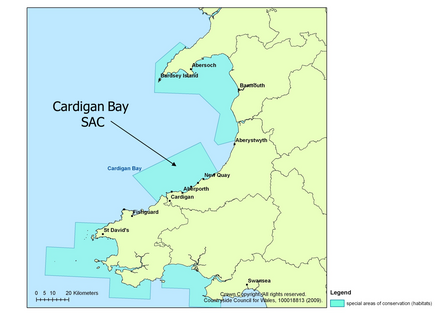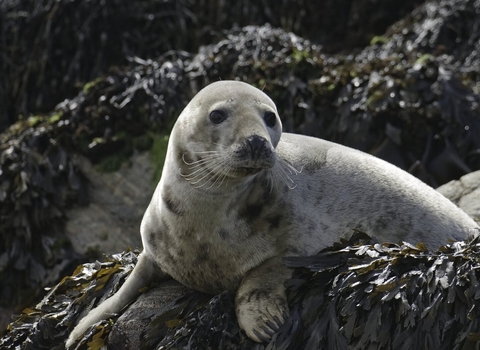Cardigan Bay dominates the coastal profile of Wales – a long sweeping arc which joins the Lleyn peninsula in the north with Pembrokeshire in the south. It is a huge lee shore that faces the prevailing winds coming in off the Atlantic.
The coastline is characterised by craggy cliffs interspersed with wide estuaries silted up with spits and bars, and the occasional island. It is a shallow bay, no more than 50m deep.
Cardigan Bay enjoys a rich marine environment, full of wildlife. Throughout the year you regularly find bottlenose dolphins, harbour porpoise, Atlantic grey seals and a variety of bird life.
Many of Cardigan Bay’s habitats and wildlife are of national and international importance. Special designations reflect this.
Cardigan Bay SAC
Stretching from Ceibwr Bay in Pembrokeshire, north to Aberarth in Ceredigion and extending almost 20km from the coast, Cardigan Bay Special Area of Conservation (SAC) protects the wildlife found in around 1000km2 of sea.
The protected area is home to an amazingly rich variety of marine animals and plants, from reef-building worms to bottlenose dolphins – the area is home to Europe’s largest population of these animals and there are few places where they are more easily seen in the wild.
There are seven features for conservation for which it is designated:
• Bottlenose dolphins (Tursiops truncatus)
• Atlantic Grey Seal (Halichoerus grypus)
• River Lamprey (Lampetra fluviatilis)
• Sea Lamprey (Petromyzon marinus)
• Reefs
• Sandbanks (slightly covered by seawater at all times)
• Sea caves (submerged or partially submerged)
Cardigan Bay SAC was designated primarily because of its importance to bottlenose dolphins. Its aim is to conserve it for generations to come.

Code of Conduct
The Ceredigion Recreational Boat Users’ Code of Conduct introduced in 1992 continues to be the main tool for managing boating activity within the SAC. The 2001 Management Scheme identified the need to provide interpretation and education that would generate interest, appreciation and a commitment to conserve the features of the SAC. The Code has been distributed to all mooring holders and visitors launching at harbours and information panels about the code and the SAC have been sited at launching sites.
In general keep a good look out and keep your distance. Do not approach marine mammals, let them come to you.
Headlands and reefs such as Mwnt, Aberporth, Ynys Lochtyn, New Quay and Sarn Cynfelyn are very important feeding areas for dolphins and porpoises; take extra care to travel slowly and not to disturb animals in these areas.
Please operate all boats with care and attention for the safety of occupants and respect
for all other sea users.
Do not discard litter or fishing tackle at sea.
Watching marine life
These are our top tips for helping you get the most out of your wildlife watching adventure.
• The best encounters are when animals are behaving naturally so don’t get too close. Follow the Ceredigion Marine Code of Conduct for wildlife watching at sea. Dolphins, whales and other marine life are sensitive to disturbance. It is an offence to deliberately hurt or recklessly disturb protected species such as dolphins.
• Always put your rubbish in a bin or take it home with you as litter can seriously harm wildlife. If you can, recycle your rubbish
• Avoid going on beaches during the breeding season where seals are known to pup. If you disturb wildlife, parents may be scared away, abandoning their young and may not return to breed there again.
• Check the tides times before you leave. Tides can rise rapidly, cutting off your exit from the beach, so keep an eye on the tide when you’re on the beach
• Keep away from cliff edges and stick to paths
Dolphin watching tips:
The first rule is: Be patient!
There is no specific time or state of the tide when sightings can be guaranteed. However, it’s best to spot dolphins on a calm day, keeping the sun behind you to avoid the glare from the sea. A disturbance of the water’s surface is often the first sign that you might see a dolphin but also look out for large flocks of excited seabirds gathering overhead; a sure sign there are plenty of fish about. Often you just catch something unusual out of the corner of your eye, so keep a pair of binoculars handy for closer observation.
Things to remember:
• Binoculars
• Notebook – to keep a note of what you spot and where
• Camera – stills or video camera, a perfect record
• ID guide – to check what you’ve seen
• Food/drink – you may be out for a while
• Warm clothing and waterproofs
Live stranded animals
To report a live stranded animal
- British Divers Marine Life Rescue 01825 765 546 (office hours) or 07787 433 412 (out of office hours)
- RSPCA (England and Wales) 0300 1234 999
If you find a live seal
Watch it from a distance. Do not approach the animal. Seals regularly haul out on our coasts – it is part of their normal behaviour and in fact they spend more time out of the water, digesting their food and resting. Therefore, finding a seal on the beach does not necessarily mean there is a problem and they should not be chased back into the sea as this may stop them from doing what they need to do – rest. A healthy seal should be left well alone.
After stormy weather and high tides, it is usual for seals to come out onto beaches to rest and re-gather their strength. Many do not need first aid but it is important to control disturbance by stopping other people and their animals from approaching the seal.
However, if there is a problem, there are a number of things you may see:
- Abandoned: If you see a seal with a white, long-haired coat in the autumn/winter, or you see a small seal (less than 3 feet in length) alone between June and August, then it is probably still suckling from its mother. Check the sea regularly for any sign of an adult seal
- Thin: Signs of malnutrition include visible ribs, hips and neck and perhaps a rather baggy, wrinkled skin
- Sick: Signs of ill health include coughing, sneezing or noisy, rapid breathing and possibly thick mucus coming from the nose; wounds or swellings, particularly on the flippers, and possibly favouring one flipper when moving (although remember that healthy seals will often lie and ‘hunch along’ on their sides); cloudy eyes, or thick mucus around them, or possibly one eye kept closed most of the time; a seal showing little response to any disturbance going on around it (although remember they could be soundly asleep)
If you find a live whale, dolphin or porpoise
A whale, dolphin or porpoise stranded on the beach is obviously not a usual phenomenon. These animals do not beach themselves under normal circumstances, and they will require assistance. Please do not return them to the sea as they may need a period of recovery before they are fit enough to swim strongly.
Important things you can do to help are:
- Provide essential first aid
- Support the animal in an upright position and dig trenches under the pectoral fins
- Cover the animal with wet sheets or towels (even seaweed) and keep it moist by spraying or dousing with water
- Do NOT cover, or let any water pass down the blowhole (nostril), sited on top of the animal’s head. This will cause the animal great distress and could even kill it
- Every movement around a stranded animal should be quiet, calm and gentle. Excessive noise and disturbance will only stress it further
- Estimate the length of the animal and look for any distinguishing feature that may give clues as to the species you are dealing with
- Look for any signs of injury and count the number of breaths (opening of the blowhole) that occur over a minute – this can give important clues as to how stressed the animal is
- Take great care when handling a dolphin, porpoise or whale; keep away from the tail, as it can inflict serious injuries – this is particularly the case with whales and it is advisable to leave handling larger whales until experienced help has arrived. Avoid the animal’s breath, as it may carry some potentially nasty bacteria
- Under no circumstances release the animal into the sea before the rescue team has arrived. It is fine to support a smaller dolphin or porpoise in the water, as long as the blowhole is kept above the water at all times, and as long as it is carried to the water carefully, e.g. in a tarpaulin (do NOT drag it or lift it by its fins or tail). However, actually releasing the animal before it has received an assessment and first aid from experienced personnel can do more harm than good
Dead stranded animals
If you find a dead stranded animal please contact the strandings network on 0800 652 0333.
The marine mammal strandings project was set up by Defra following the mass die-off of common seals in the North Sea in 1988. The purpose of the project is to monitor the health status of marine mammals and marine turtles in UK waters by examining animals that are found washed up dead on the shores. Fresh carcasses can give useful information on prey species through analysis of stomach contents, parasite burdens, pollutant levels of metals and organochlorines and give early indications of infectious diseases in these populations.
By keeping accurate records of all strandings, an indication of what species occur around the UK can be built up and records of mortality can quickly highlight unusual numbers of strandings flagging up potential problems.
The collaborative project is implemented in Wales by Marine Environmental Monitoring and funded by the Welsh Assembly Government and Natural Resources Wales.

Chris Gomersall/2020VISION
